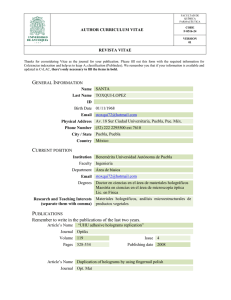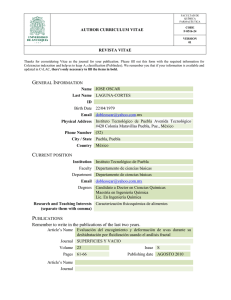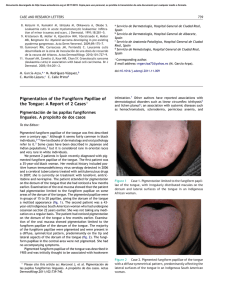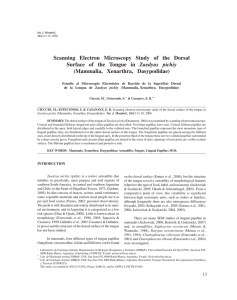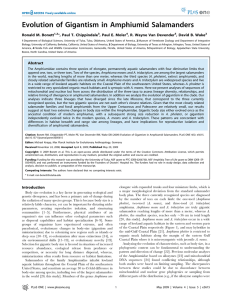Angiostoma lamotheargumedoi n. sp - E-journal
Anuncio
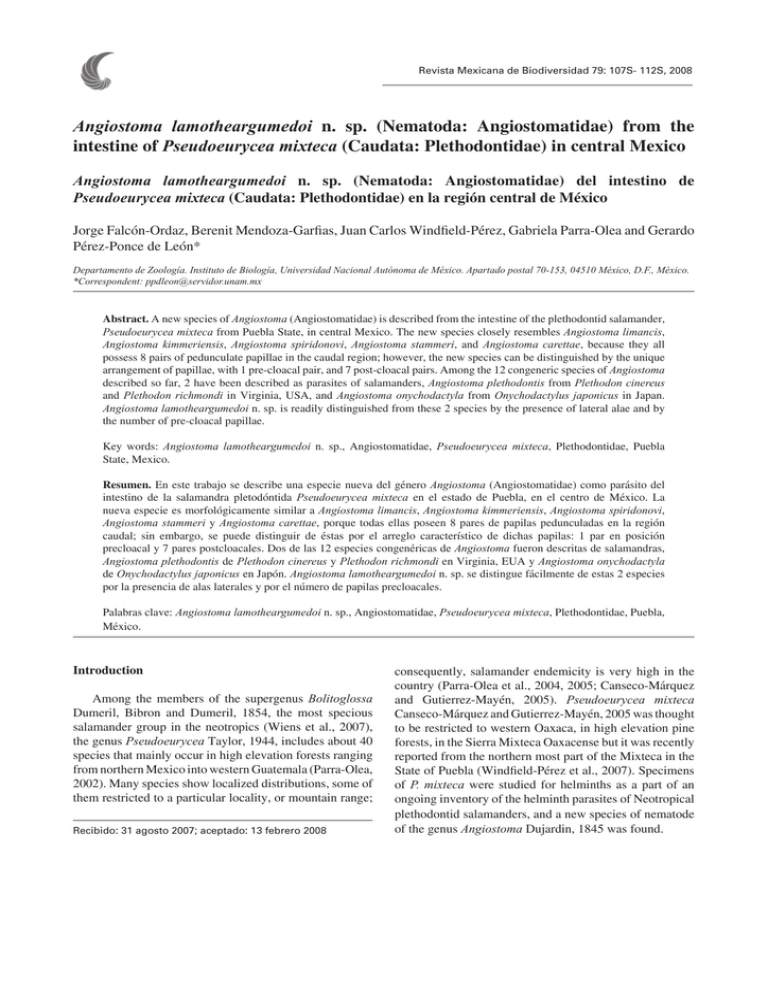
Revista Mexicana de Biodiversidad 79: 107S- 112S, 2008 Angiostoma lamotheargumedoi n. sp. (Nematoda: Angiostomatidae) from the intestine of Pseudoeurycea mixteca (Caudata: Plethodontidae) in central Mexico Angiostoma lamotheargumedoi n. sp. (Nematoda: Angiostomatidae) del intestino de Pseudoeurycea mixteca (Caudata: Plethodontidae) en la región central de México Jorge Falcón-Ordaz, Berenit Mendoza-Garfias, Juan Carlos Windfield-Pérez, Gabriela Parra-Olea and Gerardo Pérez-Ponce de León* Departamento de Zoología. Instituto de Biología, Universidad Nacional Autónoma de México. Apartado postal 70-153, 04510 México, D.F., México. *Correspondent: [email protected] Abstract. A new species of Angiostoma (Angiostomatidae) is described from the intestine of the plethodontid salamander, Pseudoeurycea mixteca from Puebla State, in central Mexico. The new species closely resembles Angiostoma limancis, Angiostoma kimmeriensis, Angiostoma spiridonovi, Angiostoma stammeri, and Angiostoma carettae, because they all possess 8 pairs of pedunculate papillae in the caudal region; however, the new species can be distinguished by the unique arrangement of papillae, with 1 pre-cloacal pair, and 7 post-cloacal pairs. Among the 12 congeneric species of Angiostoma described so far, 2 have been described as parasites of salamanders, Angiostoma plethodontis from Plethodon cinereus and Plethodon richmondi in Virginia, USA, and Angiostoma onychodactyla from Onychodactylus japonicus in Japan. Angiostoma lamotheargumedoi n. sp. is readily distinguished from these 2 species by the presence of lateral alae and by the number of pre-cloacal papillae. Key words: Angiostoma lamotheargumedoi n. sp., Angiostomatidae, Pseudoeurycea mixteca, Plethodontidae, Puebla State, Mexico. Resumen. En este trabajo se describe una especie nueva del género Angiostoma (Angiostomatidae) como parásito del intestino de la salamandra pletodóntida Pseudoeurycea mixteca en el estado de Puebla, en el centro de México. La nueva especie es morfológicamente similar a Angiostoma limancis, Angiostoma kimmeriensis, Angiostoma spiridonovi, Angiostoma stammeri y Angiostoma carettae, porque todas ellas poseen 8 pares de papilas pedunculadas en la región caudal; sin embargo, se puede distinguir de éstas por el arreglo característico de dichas papilas: 1 par en posición precloacal y 7 pares postcloacales. Dos de las 12 especies congenéricas de Angiostoma fueron descritas de salamandras, Angiostoma plethodontis de Plethodon cinereus y Plethodon richmondi en Virginia, EUA y Angiostoma onychodactyla de Onychodactylus japonicus en Japón. Angiostoma lamotheargumedoi n. sp. se distingue fácilmente de estas 2 especies por la presencia de alas laterales y por el número de papilas precloacales. Palabras clave: Angiostoma lamotheargumedoi n. sp., Angiostomatidae, Pseudoeurycea mixteca, Plethodontidae, Puebla, México. Introduction Among the members of the supergenus Bolitoglossa Dumeril, Bibron and Dumeril, 1854, the most specious salamander group in the neotropics (Wiens et al., 2007), the genus Pseudoeurycea Taylor, 1944, includes about 40 species that mainly occur in high elevation forests ranging from northern Mexico into western Guatemala (Parra-Olea, 2002). Many species show localized distributions, some of them restricted to a particular locality, or mountain range; Recibido: 31 agosto 2007; aceptado: 13 febrero 2008 consequently, salamander endemicity is very high in the country (Parra-Olea et al., 2004, 2005; Canseco-Márquez and Gutierrez-Mayén, 2005). Pseudoeurycea mixteca Canseco-Márquez and Gutierrez-Mayén, 2005 was thought to be restricted to western Oaxaca, in high elevation pine forests, in the Sierra Mixteca Oaxacense but it was recently reported from the northern most part of the Mixteca in the State of Puebla (Windfield-Pérez et al., 2007). Specimens of P. mixteca were studied for helminths as a part of an ongoing inventory of the helminth parasites of Neotropical plethodontid salamanders, and a new species of nematode of the genus Angiostoma Dujardin, 1845 was found. 108S Falcón-Ordaz et al.- New species of Angiostoma in plethodontids from Mexico Members of Angiostoma are mainly parasites of terrestrial gastropods, with 9 species distributed in Western Europe and Australia; however, 2 species have been found in salamanders and, more recently, 1 species was described from the lungs of the loggerhead sea turtle, Caretta caretta (Linnaeus, 1758) (Bursey and Manire, 2006). Angiostoma plethodontis Chitwood, 1933, was described from the northern redback salamander, Plethodon cinereus Green in Virginia, USA (Chitwood, 1933), and Angiostoma onychodactyla Bursey and Goldberg, 2000, was described from the Japanese clawed salamander, Onychodactylus japonicus (Houttuyn) in Honshu, Japan (Bursey and Goldberg, 2000). In this paper, a new species of Angiostoma from the intestine of P. mixteca in central Mexico is described. Materials and methods Fourteen plethodontid salamanders (P. mixteca) were collected by hand in a sinkhole near the locality of Tepanco de López, Puebla State, in December, 2004, and July, 2006 (Fig. 1). After capture, salamanders were killed with an overdose of anesthetic (sodium pentobarbitol), and dissected. Nematodes were recovered by opening the intestine and rectum with small blunt-nosed scissors and searching the mucosal side with a stereoscope. Nematodes were placed in 8.5% saline, fixed with glacial acetic acid, and stored in 70% ethanol. Specimens were cleared for study with lactophenol. Drawings and measurements were made with a Zeiss microscope equipped with a drawing tube. For scanning electron microscopy (SEM) study, nematodes were dehydrated in series of gradual ethanol and critical point dried with carbon dioxide. Specimens were coated with gold and examined in a Hitachi S-2460N scanning electron microscope at 15kV. Measurements are given in micrometers (μm) unless otherwise indicated, and presented as the range, with the mean, standard deviation, and sample size in brackets, followed by the measurements of the holotype and allotype in parentheses. The specimens were deposited in the Colección Nacional de Helmintos (CNHE), Instituto de Biología, Universidad Nacional Autónoma de México (UNAM). Hosts were deposited at the Colección Nacional de Anfibios y Reptiles (CNAR), Instituto de Biología, Universidad Nacional Autónoma de México (UNAM) with the accession numbers: IBH 14350, 18701-18716. For comparison, specimens deposited at the U.S. National Parasite Collection (USNPC) were studied as follow: A. plethodontis ex Triturus vulgaris vulgaris (Linnaeus, 1758) (065662), A. onychodactyla ex O. japonicus (088647), Angiostoma aspersae Morand, 1986 ex Mertensiella luschani (Steindachner, 1891) (094464), Figure 1. Map of Mexico showing the locality where the plethodontid salamanders were collected in Puebla State. and Angiostoma carettae Bursey and Manire, 2006 ex C. caretta (095696). Description Angiostoma lamotheargumedoi n. sp. (Figs. 2A-F, 3A-B) Small nematodes with transparent body. Two pairs of cuticular lateral alae present, both starting approximately at the level of the esophageal isthmus and extending posteriorly to the level of the bursa in males, and to the level of the tail in females. Oral opening wide, with 3 lips and 2 amphids. Thick-walled buccal cavity. Esophagus with isthmus and posterior glandular bulb. Male with 1 pair of well-developed caudal alae supported by 8 pedunculated papillae; spicules paired, similar, proximal end thickened, pointed distal end; gubernaculum present. Females with pre-equatorial vulva, near mid-body; vagina short; amphidelphic; ovaries flexed; eggs were not observed. Male: Based in 12 mature specimens. Length 1.19–2.29 mm (1.69 mm ± 0.33, n = 11) (1.75 mm); maximum width 50-70 (60 ± 6, n = 11) (60). Buccal cavity 6-15 (14 ± 3, n = 11) (15) long. Esophagus 150-220 (190 ± 21, n = 10) (200) long, consisting of corpus 75-140 (112 ± 18, n = 10) (111) long, isthmus 30-70 (50 ± 12, n = 10) (45) long, and bulb 20-35 (28 ± 5, n = 10) (30) long, 18-21 (20 ± 2, n = 10) (21) wide. Distance from anterior end to nerve ring (60) and to excretory pore (162). Spicules equal, 50-80 (68 ± 9, n = 11) (55), well sclerotized and curved. Gubernaculum wellsclerotized, 20-30 (27 ± 4, n = 9) (28) long. Two caudal alae well-developed supported by 8 pairs of pedunculate papillae; 1 pair precloacal, 7 pairs postcloacal arranged in 3 groups, 2 pairs close to cloaca, 3 pairs midway between cloaca and tail, and 2 pairs close to tail. Tail extending beyond bursa. Revista Mexicana de Biodiversidad 79: 107S- 112S, 2008 109S Figure 2. Angiostoma lamotheargumedoi n. sp. 2A, cross section at midbody of a male showing 2 pairs of lateral alae (scale bar: 0.05 mm). 2B, in face view of male showing lips and papillae (scale bar: 0.01 mm). 2C, male, entire, lateral view (scale bar: 0.25 mm). 2D, posterior end of male, ventral view showing caudal alae, pedunculated papillae and spicules (scale bar: 0.05 mm). 2E, posterior end of male, lateral view. 2F, female, entire, lateral view (scale bar: 0.25 mm). Female: From 15 mature specimens. Length 1.32-2.25 mm (1.9 mm ± 0.35, n = 14) (2.14 mm), maximum width at level of vulva 40-75 (59 ± 11, n = 14) (72). Buccal cavity 9-18 (15 ± 2, n = 14) (15), long. Esophagus 156219 (192 ± 19, n = 13) (210) long, consisting of corpus 66-135 (115 ± 17, n = 11) (126) long, isthmus 30-63 (47 ± 13, n = 11) (54) long, and bulb 24-33 (29 ± 3, n = 11) (30) long, 18-30 (22 ± 3, n = 11) (21) wide. Distance from anterior end to nerve ring (81) and to excretory pore (180). Vulva 580-1000 (848 ± 135, n = 12) (984) from anterior end. Tail conical 36-123 (75 ± 23, n = 14) (63) long. Eggs not observed in uterus. 110S Falcón-Ordaz et al.- New species of Angiostoma in plethodontids from Mexico Remarks Figure 3. Scanning electron micrographs of Angiostoma lamotheargumedoi n. sp. 3A, anterior end of male showing the 1 pair of lateral alae (scale bar: 0.04 mm). 3B, posterior end of male, lateral view, showing caudal alae with pedunculated papillae and spicules (scale bar: 0.02 mm) and the posterior end of lateral alae. Taxonomic Summary Type-host: Pseudoeurycea mixteca Canseco-Márquez and Gutierrez-Mayén, 2005. Site: intestine. Type-locality: a sinkhole near the locality of Tepanco de López, Puebla State (19°20’20”N, 98°43’14”W, altitude: 3230 m.). Prevalence and mean abundance: 6/14, 42.8% (7.2 worms per analyzed host). Type-specimens: holotype (5914), allotype (5915), paratypes (5916-5917), vouchers (5918-5919), deposited in the Colección Nacional de Helmintos, México D.F., Mexico (CNHE). Etymology: the species is named after Dr. Rafael Lamothe Argumedo in recognition of his outstanding contribution to Mexican parasitology. So far, 12 species of Angiostoma have been described; 9 as parasites of terrestrial gastropods, 1 in a marine turtle, and 2 in salamanders (Table 1). Angiostoma lamotheargumedoi n sp. closely resembles Angiostoma limancis Dujardin, 1845, A. kimmeriensis Korol and Spiridonov, 1991, A. spiridonovi Morand,1992, A. stammeri Mengert, 1953, and A. carettae, because they all possess 8 pairs of pedunculate papillae in the caudal region; however, the new species can be distinguished by the unique arrangement of papillae, with 1 pre-cloacal pair, and 7 post-cloacal pairs. In addition, the aforementioned species lack lateral alae, and the new species is characterized by having 2 pairs of cuticular lateral alae. Two species of Angiostoma have been described as parasites of salamanders, and 1 of them in particular in plethodontids. Angiostoma plethodontis was described by Chitwood (1933) as a parasite of P. cinereus in Virginia, USA, and more recently was recorded from Plethodon richmondi Nettin and Mittleman, 1938, in the same locality by Emery and Joy (2000). The second species is A. onychodactyla from the hynobiid salamander O. japonicus in Japan. The new species is readily distinguished from the 2 congeneric species found in salamanders by the presence of lateral alae and by the number of pre-cloacal papillae. Angiostoma plethodontis and A. onychodactyla lack lateral alae and there are 2 pairs of pre-cloacal papillae or no papillae, respectively, whereas in the new species only 1 pair of pre-cloacal papillae is present. The current inventory of the helminth parasites of Neotropical plethodontid salamanders is still in initial stages, with the nematode Cosmocerca acanthurum Falcón-Ordaz, Windfield-Pérez, Mendoza-Garfias, ParraOlea and Pérez-Ponce de León, 2007 being the first species described (Falcón-Ordaz et al., 2007). These authors predicted that the helminth fauna of neotropical salamanders would be found to be species-poor, with low abundance values, and mainly be dominated by nematodes with direct or indirect life-cycles. The finding presented herein provide additional support for that prediction since only 1 species of nematode was found as a parasite of P. mixteca. The microhabitat where the host was reported is quite unusual for a plethodontid salamander, since they were found in a sinkhole at the border between oak forest and xerophile vegetation. Adult organisms were found in the sinkhole at about 80 meters below surface level under stones in humid sand or burrowed about 30 cm beneath the sinkhole surface (Windfield-Pérez et al., 2007). This fact poses interesting questions regarding the infection mechanism of this species. Most probably, the new species could have been a result of a host-switching event from Revista Mexicana de Biodiversidad 79: 107S- 112S, 2008 111S Table 1. List of species of Angiostoma with their main diagnostic traits Host Lateral alae Pre-cloacal papillae (pairs) A. limancis Dujardin, 1845 Arion ater Absent A. kimmeriensis Korol and Spiridonov, 1991 Oxychilus deilus Post-cloacal papillae (pairs) Spicules μm 3 6 110 40 Absent 3 5 125 50 Schizoglossa novoseelandica Absent 3 1 6 80 25 Limas flavus Absent 2 1 5 82 35 A. stammeri Mengert, 1953 Limas cinereoniger and L. maximus Absent 2 1 5 101-125 65-70 A. aspersae Morand, 1986 Helix aspersa Present 4 (+ 1) 7 75 35 A. dentifera Mengert, 1953 Limas cinereoniger Present 5 4 55 30 A. asamati Spiridonov, 1985 Turcomilax ferganus Present 2 4 136 47 A. coloaense Van Luc, Spiridonov and Wilson, 2005 Cyclophorus sp. Present 2 7 138 58 Caretta caretta Absent 3 5 41 18 Plethodon cinereus Absent 2 7 60 25 A. onychodactyla Bursey and Goldberg, 2000 Onychodactylus japonicus Absent 0 8 128 44 A. lamotheargumedoi n. sp. Pseudoeurycea mixteca Present 1 7 60 27 A. schizoglossae Morand and Baker, 1995 A. spiridonovi Morand,1992 A. carettae Bursey and Manire, 2006 A. plethodontis Chitwood, 1933 a gastropod. Whether or not their sister species is found in the same unusual habitat needs to be confirmed by finding gastropods infected with nematodes. Prevalence and abundance values, albeit low, prevent any expectation that the new species is actually a parasite of gastropods. Members of Angiostoma seem to be parasites primarily of gastropod mollusks (see Table 1) (see Morand et al., 2004), with a few species in amphibians that shares the same habitat with gastropods. The presence of a species of Angiostoma in a marine turtle (C. caretta) represents a very unusual finding, and future taxonomic papers will need to clarify the status of this species; however, our Adanal papillae (pairs) Gubernaculum μm observation of the type-specimens (USNPC No. 095696) of this species indicate they belong to Angiostoma. Acknowledgements We thank the following persons for their help during field and laboratory work: Gabriel Barrios Quiroz, Ruth Percino, Patricia Frías, Lizbeth Hernández Zárate, and Rogelio Rosas Valdez. We also wish to thank people in the locality, Saúl Parra and José Parra for their help in the logistics to get access to the sinkhole. This project was 112S Falcón-Ordaz et al.- New species of Angiostoma in plethodontids from Mexico partially funded by grants from SEMARNAT-CONACYT 2002-C01/0015 and the Programa de Apoyo a Proyectos de Investigación e Inovación Tecnológica (PAPIIT-UNAM) grant No. IN226605 to GPO. Literature cited Bursey, C. R. and S. R. Goldberg. 2000. Angiostoma onychodactyla sp. n. (Nematoda: Angiostomatidae) and other intestinal helminths of the japanese clawed salamander, Onychodactylus japonicus (Caudata: Hynobiidae), from Japan. Comparative Parasitology 67:60-65. Bursey, C. R. and C. A. Manire. 2006. Angiostoma carettae n. sp. (Nematoda: Angiostomatidae) from the loggerhead sea turtle Caretta caretta (Testudines: Cheloniidae), Florida, U.S.A. Comparative Parasitology 73:253-256. Canseco-Márquez, L. and G. Gutiérrez-Mayén. 2005. New species of Pseudoeurycea (Caudata: Plathodontidae) from the mountains of the Mixteca Region of Oaxaca, Mexico. Journal of Herpethology 39:181-185. Chitwood, B.G. 1933. On some nematodes of the superfamily Rhabditoidea and their status as parasites of reptiles and amphibians. Journal of the Washington Academy of Sciences 23:508-520. Emery, M. B. and J. E. Joy. 2000. Endohelminths of the Ravine Salamander, Plethodon richmondi, from Southwestern West Virginia, USA. Comparative Parasitology 67:133-135. Flacón-Ordaz, J., J. C. Winfield-Pérez, B. Mendoza-Garfias, G. Parra-Olea and G. Pérez-Ponce de León. 2007. Cosmocerca acanthurum n. sp. (Nematoda: Cosmocercidae) in Pseudoeurycea leprosa and Chiropterotriton orculus from the Transmexican Volcanic Belt, central Mexico, with a checklist of the helminth parasites of plethodontid salamanders. Zootaxa 1434:27-49. Morand, S., M. J. Wilson and D. M. Glen. 2004. Nematodes (Nematoda) parasitic in terrestrial gastropods. In Natural enemies of terrestrial molluscs, G. M. Barker (ed.). CABI, Wallingford. p. 525-557. Parra-Olea, G. 2002. Phylogenetic relationships of the salamander of the genus Pseudoeurycea (Caudata: Plethodontidae). Molecular Phylogenetics and Evolution 22:234-246. Parra-Olea, G., L. Canseco-Márquez and M. García-París. 2004. A morphologically distinct new species of Pseudoeurycea (Caudata:Plethodontidae) from the Sierra Madre Oriental of Puebla, México. Herpetologica 64:78-84. Parra-Olea, G., M. García-París, M., J. Hanken and D. B. Wake. 2005. Two new species of Pseudoeurycea (Caudata: Plethodontidae) from the mountains of northern Oaxaca, México. Copeia 2005:461-469. Wiens, J. J., G. Parra-Olea, M. García-París and D. B. Wake. 2007. Phylogenetic history explains elevational biodiversity patterns in tropical salamanders. Proceedings of the Royal Society of London B 274:919-928. Windfield-Pérez J. C., G. Parra-Olea and L. Hernández-Zárate. 2007. Registro de Pseudoeurycea mixteca (Caudata: Plethodontidae) en una cueva de Tehuacán, Puebla. Revista Mexicana de Biodiversidad 78:493-495.
